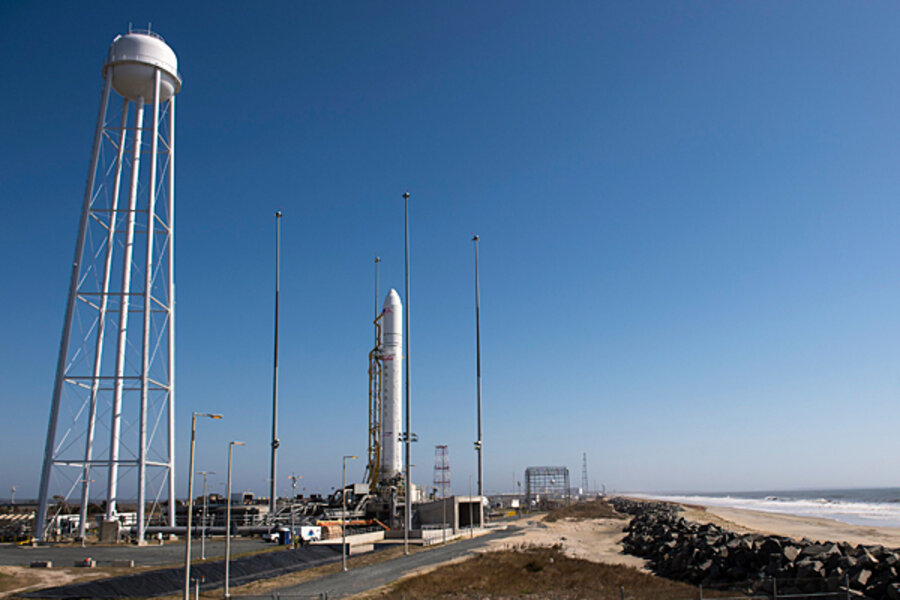NASA's other rocket for hire, Antares, is poised for test launch
Loading...
Orbital Sciences Corp., one of two companies NASA has hired to ferry cargo to the International Space Station (ISS), is set for the first test launch of a new rocket it has built to handle the task.
Liftoff of the rocket, dubbed Antares, currently is scheduled for early Wednesday evening EDT from a new launch pad built at NASA's Wallops Island Flight Facility on the Virginia coast.
"It's going to be the biggest and loudest and brightest thing that's ever been launched from Wallops," says Frank Culbertson, a former NASA astronaut and the executive vice president who oversees Orbital Sciences' advanced-programs group. The facility typically launches sounding rockets, research balloons, and conducts aviation research. It hasn't been the site of an orbital mission since 1985.
This mission's goal is to place a dummy version of the company's Cygnus cargo carrier into orbit. If it succeeds, the company aims to launch a loaded cargo module to the station this summer in a demonstration of its ability to meet NASA's standard for operating at the space station. If all goes well on that mission, the company plans the first formal delivery of cargo in the fall, under a $1.9-billion contract with the space agency.
For Orbital Sciences, Wednesday's launch represents a vital milestone along its path from late entry into NASA under the agency's Commercial Orbital Transportation Services (COTS) program to launch pad.
"My confidence level is very high," Mr. Culbertson said during a prelaunch briefing Tuesday. The company has been working on the rocket for six years. It's the latest in a line of launch vehicles the company has built in the more than 30 years it has been building rockets, satellites, and other space hardware for civilian and military use.
For NASA, Antares and the new launch facility built to service it represent "a critical capability not only for NASA and the ISS program, but for the entire nation," offers Phil McAlister, the agency's director of commercial spaceflight development.
"We saw after Columbia how tenuous our lifeline is to low-Earth orbit," he adds, referring to the Columbia disaster in February 2002, when the shuttle disintegrated on reentry, killing its seven-member crew. "That one tragic accident made it really challenging for NASA to maintain the ISS during that very difficult period of time."
Having two companies ferrying goods, each using independently designed and built rockets and independent launch facilities, provides "assured access -- a significantly higher confidence level in our ability to deliver cargo" in ways that can help the station become the research lab it was intended to be. It also could increase the prospect of adding a seventh crew member to the space station's complement to help conduct research, rather than the current six crew members, he says.
For the region of the Virginia coast that hosts Wallops Island and its Mid Atlantic Regional Spaceport, which sits at the southern tip of NASA's facility, regular cargo service to the space station and orbital launches for other customers mean jobs, noted Dale Nash, executive director of Virginia's Commercial Spaceflight Authority.
Unlike Space Exploration Technology Corp. (SpaceX), which completed its second successful space-station resupply mission in March, Orbital Sciences is a latecomer to NASA's commercial-transport program, notes Lennard Fisk, a professor of space science at the University of Michigan in Ann Arbor and a member of Orbital Science's board of directors.
He notes that initially, NASA picked SpaceX and another newcomer to the aerospace industry, Rocketplane Kistler, to transport cargo and eventually crews to the space station.
Part of the deal with NASA involved raising money to share the financial risk of developing their spacecraft. SpaceX had the deep pockets of founder and chief technology officer Elon Musk, co-founder of the online payment service PayPal. That was augmented by investments from private-equity firms.
But Rocketplane Kistler was unable to meet the financial milestones NASA set for it. Just over a year after NASA announced the two companies as participants, the agency canceled its agreement with Rocketplane Kistler.
Meanwhile, Orbital Sciences had been developing a new "medium lift" rocket to replace older rockets in its stable with comparable cargo capacity. And NASA was looking to replace Rocketplane Kistler as the second cargo carrier under the COTS program.
"It was a good fit," Culbertson said of NASA's interest in what Orbital Sciences could offer.
Now, after a six-year effort to erect Antares on a launch pad, "the hardware is ready, it's been through its own testing, and I think we're going to see a nice show tomorrow," Culbertson said.
The launch window runs from 5 p.m. to 8 p.m. Wednesday, and mission planners say they hope to loft Antares as early as possible during that time span. The current weather forecast calls for a 55 percent chance that conditions will be unacceptable for launch.







